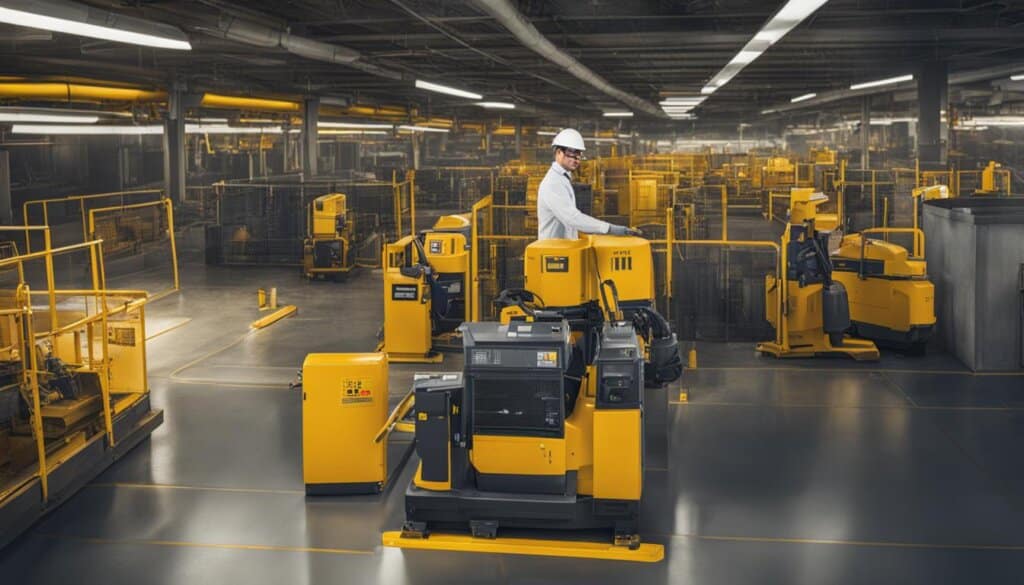Table of Contents
Quality control is an essential aspect of ensuring customer satisfaction, meeting regulatory requirements, and establishing efficient processes in a laboratory setting. Implementing a quality management system (QMS) in the laboratory is crucial for maintaining the reliability of operations. The Clinical and Laboratory Standards Institute (CLSI) has identified 12 important elements, known as Quality System Essentials, that act as building blocks for developing a QMS in medical laboratories. These essentials include organization, facilities and safety, personnel, equipment, purchasing and inventory, process control, information management, documents and records, occurrence management, assessment, process improvement, and customer service. Compliance with these essentials is ensured through audits and continuous improvement efforts.
The Importance of Organization in Quality Control
In quality control, having a clear organizational structure is essential. The laboratory should demonstrate who has overall responsibility for laboratory activities and the reporting structure within the organization. An organogram or organizational chart is a valuable tool for visualizing this structure. Additionally, the laboratory should have planning and control mechanisms in place to ensure smooth day-to-day and periodic tasks, creating a well-oiled system.
Having a well-organized organizational structure is vital for effective quality control. It establishes clear lines of responsibility and accountability, ensuring that everyone understands their roles and how they contribute to the overall goals of the laboratory. An organogram or organizational chart visually represents the reporting structure and hierarchies within the organization, allowing for better communication and coordination among team members.
Efficient planning and control mechanisms are also crucial in quality control. These mechanisms ensure that tasks are allocated, deadlines are met, and resources are utilized optimally. Effective planning involves setting objectives, defining strategies, and allocating resources to achieve those objectives. It helps in setting priorities, managing time, and allocating tasks effectively. Control mechanisms, on the other hand, involve monitoring progress, identifying deviations, and taking corrective actions to stay on track.
When planning and control mechanisms are in place, the laboratory operates like a well-oiled system. It becomes more agile, adaptable, and responsive to changing circumstances. This enhances efficiency, productivity, and overall quality of operations. A well-organized and well-controlled system minimizes errors, reduces delays, and ensures that tasks are completed accurately and on time.
Benefits of a Well-Organized System in Quality Control
A well-organized system in quality control offers several benefits to the laboratory:
- Efficient resource allocation: With clear roles and responsibilities, resources can be allocated effectively, ensuring optimal utilization and preventing duplication of efforts.
- Smooth communication and coordination: An organized structure promotes better communication channels and coordination among team members, leading to improved collaboration and workflow.
- Effective decision-making: When responsibilities are clearly defined, decision-making becomes streamlined and efficient, enabling prompt and effective actions to be taken.
- Improved accountability: A well-organized system helps establish accountability at all levels, ensuring that individuals are responsible for their actions and deliverables.
- Enhanced quality and customer satisfaction: By implementing planning and control mechanisms, quality control processes become more efficient, leading to improved quality and customer satisfaction.
By focusing on organization, organizational structure, planning, and control, laboratories can establish a well-oiled system that contributes to a high level of quality control. Embracing these principles enables laboratories to operate efficiently, deliver accurate results, and meet the highest standards in their industry.
Ensuring Safety and Efficiency through Facilities and Safety Standards
Safety is of utmost importance in a laboratory setting. The well-being of staff and visitors should be a top priority, especially when working with infectious materials. To achieve this, laboratories must establish and maintain facilities and safety standards that provide a secure and safe environment.
Physical containment measures are crucial to prevent the spread of hazardous substances and materials. This includes the proper design and construction of laboratories, incorporating features such as sealed containment systems, exhaust ventilation, and negative pressure rooms. By implementing these measures, laboratories can minimize the risk of exposure to harmful substances and protect personnel and visitors from potential hazards.
Worker safety protocols play a significant role in ensuring the safety of laboratory personnel. Adequate training, proper use of personal protective equipment (PPE), and adherence to safety guidelines are essential. This includes protocols for handling hazardous materials, operating specialized equipment, and responding to emergencies. Regular safety drills and ongoing training programs help reinforce these protocols and promote a culture of safety awareness among all laboratory staff.
Ergonomics also play a crucial role in maintaining a safe and efficient laboratory environment. By considering the design of workstations, equipment, and workflows, laboratories can help prevent musculoskeletal injuries and discomfort. Ergonomic principles should be applied to minimize repetitive movements, optimize posture, and ensure the proper positioning of equipment and supplies. This not only enhances worker safety but also improves overall productivity and efficiency.
“Laboratories must have procedures and standards in place to maintain a safe, secure, and clean environment. This includes proper waste management and disposal procedures, regular cleaning and sanitization, and effective pest control measures.”
By maintaining safety standards, laboratories create a safe environment for everyone involved, supporting worker productivity and ensuring the integrity of scientific experiments and analyses.

| FACILITIES AND SAFETY STANDARDS | KEY ELEMENTS |
|---|---|
| Physical Containment | Design and construct laboratories with sealed containment systems, exhaust ventilation, and negative pressure rooms to minimize the spread of hazardous substances. |
| Worker Safety Protocols | Provide training, personal protective equipment (PPE), and clear guidelines for handling hazardous materials, operating specialized equipment, and responding to emergencies. |
| Ergonomics | Apply ergonomic principles in the design of workstations, equipment, and workflows to reduce the risk of musculoskeletal injuries and optimize productivity. |
| Safe Environment | Maintain proper waste management and disposal procedures, implement regular cleaning and sanitization practices, and ensure effective pest control measures. |
The Role of Personnel in Quality Control
In any laboratory setting, personnel play a crucial role in ensuring quality control. The decisions made by staff members regarding methods and results have a direct impact on the accuracy and reliability of laboratory processes, even as automation technologies advance. Therefore, it is essential to have personnel with the appropriate qualifications and job descriptions in place to outline their responsibilities.
Staff management begins with hiring individuals who possess the necessary qualifications and skills for their respective roles. This ensures that the personnel have the knowledge and expertise required to carry out their tasks effectively. Job descriptions provide a clear understanding of the responsibilities and expectations associated with each position, fostering a sense of accountability among the staff. By aligning personnel qualifications and job descriptions, laboratories can optimize productivity and maintain high standards of quality control.
Training is a vital aspect of personnel development in quality control. Upon joining the laboratory, employees should undergo comprehensive training programs designed to familiarize them with the laboratory’s processes, equipment, and quality control procedures. Ongoing training and competency assessment should also be conducted regularly to ensure that staff members have the necessary skills and knowledge to perform their duties accurately and efficiently. Continuous improvement efforts in training contribute to maintaining staff competence and upholding quality control standards.
Motivation is an often-overlooked factor in quality control efforts. Engaged and motivated staff members are more likely to perform at their best, going above and beyond to contribute to overall quality control initiatives. Creating a positive work environment, recognizing achievements, and providing opportunities for professional growth can significantly impact staff motivation. By prioritizing the well-being and job satisfaction of personnel, laboratories can foster a culture of excellence and quality consciousness.
“The key to quality control success lies in personnel management, from ensuring the right qualifications and job descriptions to providing comprehensive training and fostering staff motivation.” – Dr. Rebecca Smith, Quality Assurance Expert
By recognizing the crucial role of personnel and implementing effective staff management strategies, laboratories can elevate their quality control efforts and maintain consistently high standards.
Key Elements of Equipment and Purchasing Management in Quality Control
When it comes to quality control in the laboratory, equipment plays a critical role. Making evidence-based decisions in equipment choice is crucial for maintaining accuracy and reliability. It is essential for laboratories to maintain an inventory of all equipment and carry out scheduled maintenance activities to ensure optimal functionality. By implementing effective equipment maintenance practices, laboratories can prevent downtime and costly repairs, ultimately contributing to improved quality control.
In addition to equipment management, effective purchasing and inventory management are also key elements of quality control. The quality of supplies directly impacts laboratory processes, making it crucial to choose the right products and suppliers. By carefully selecting suppliers and implementing a robust inventory management system, laboratories can ensure uninterrupted service and availability of supplies when needed. This not only helps maintain process control but also enhances overall quality control efforts.
By focusing on equipment management, purchasing, inventory management, and suppliers, laboratories can optimize their quality control processes. Effective process control is achieved when laboratories prioritize evidence-based decisions, scheduled equipment maintenance, strategic purchasing, and efficient inventory management. These key elements lay the foundation for successful quality control and enable laboratories to deliver accurate and reliable results to meet the needs of their customers and regulatory requirements.
FAQ
What is the importance of quality control in a laboratory setting?
Quality control is vital to ensure customer satisfaction, meet regulatory requirements, and establish efficient processes in the laboratory.
What is a quality management system (QMS) in a laboratory?
A quality management system (QMS) is a systematic approach to ensuring the reliability and effectiveness of laboratory operations.
What are the 12 Quality System Essentials identified by the Clinical and Laboratory Standards Institute (CLSI)?
The 12 Quality System Essentials are organization, facilities and safety, personnel, equipment, purchasing and inventory, process control, information management, documents and records, occurrence management, assessment, process improvement, and customer service.
How is compliance with the Quality System Essentials ensured?
Compliance with the Quality System Essentials is ensured through audits and continuous improvement efforts.
Why is having a clear organizational structure important in quality control?
A clear organizational structure helps define responsibilities and reporting lines within the laboratory, ensuring efficient operations.
What should be considered when ensuring safety in a laboratory setting?
Safety measures should include physical containment, worker safety protocols, and ergonomic considerations to provide a secure environment for staff and visitors.
What role do personnel play in quality control within a laboratory?
Personnel play a crucial role in decision-making, method selection, and maintaining the quality of laboratory results. They should have the appropriate qualifications and job descriptions, undergo regular training and competency evaluations.
What is the significance of equipment in quality control?
Equipment is a critical component of quality control in the laboratory, and evidence-based decisions should be made when choosing and maintaining equipment. Effective purchasing and inventory management are also vital for uninterrupted service and process control.
How does effective purchasing and inventory management contribute to quality control?
Effective purchasing and inventory management ensure the availability of supplies and contribute to process control, ultimately supporting overall quality control efforts in the laboratory.













